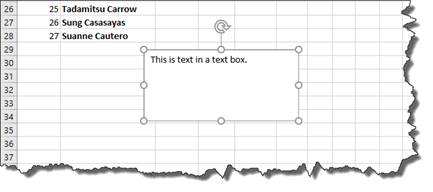Adding Images and Graphicsin Excel 2016
You can enter images and graphics into Excel simply to associate them with a particular piece of information. For instance, if you were creating a catalog of items in a museum, you might want to include a picture of the item next to its description. But you can also use them to make your projects more visually appealing.
Adding Images
You can add images into Excel from a file or directly from a scanner or camera. We'll show you how to add an image stored on your computer first.
To do this, select the cell that will represent the top left corner of your picture.
Next, go to the Insert tab and click Picture.

A dialogue box is displayed that allows you to search your computer for the image you want to use.
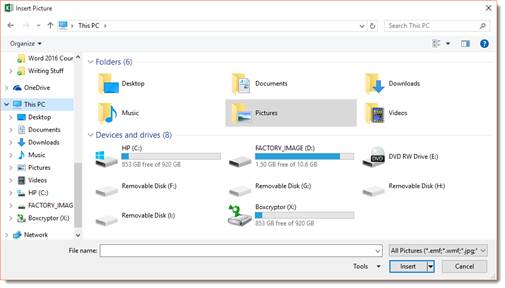
Navigate to the folder that contains the picture you'd like to insert, select the picture, and double-click it or click Insert.
The image now appears in your spreadsheet:
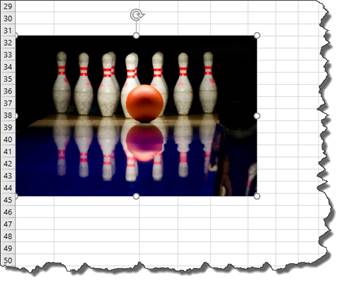
When you insert a picture into Excel, the Picture Format tab automatically opens in the Ribbon.

This tab contains the tools you'll need to modify an image or element. We'll talk about it more later on in this lesson.
You can also insert pictures from memory cards and external devices hooked up to your computer. Follow the same steps and locate the device, then navigate to the picture you want to use.
Adding Online Pictures and Clipart
You can also insert MS Office clipart, images you find using Bing search, and images from your OneDrive into a spreadsheet. To do this, click the Online Pictures button.

When you click the button, this window will appear:
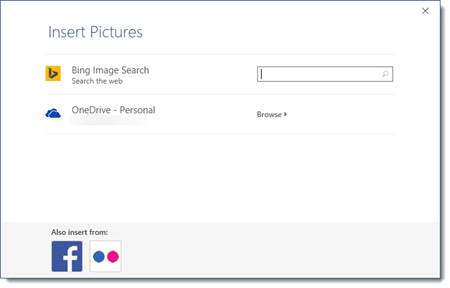
If you want to search for ClipArt, type in a description of what you're looking. Use keywords, such as coffee, woman, shopping, etc.
We're going to type in coffee.

Select the picture you want by clicking on it, then click Insert.
NOTE: Before you insert any image into your document that will be distributed to others, make sure you check the copyright to be sure you can legally use the image. To avoid copyright issues, either use your own images, images that are in the public domain (no copyright), or purchase images from stock photo sites where you will receive a license with the image.
Inserting Pictures from OneDrive
In addition to inserting pictures from Bing search, you can also insert pictures stored on your OneDrive.
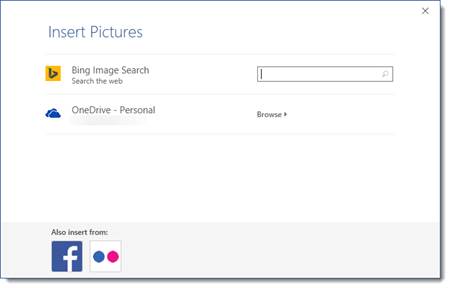
Click Browse.
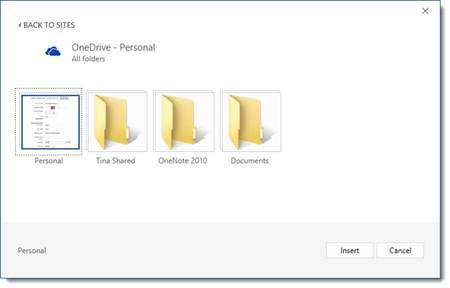
Find the image you want, then click the Insert button.
Insert Images from Facebook and Flickr
To insert images from Facebook or Flickr, click the Online Pictures button again.
For Facebook, click the Facebook icon at the bottom of the window.
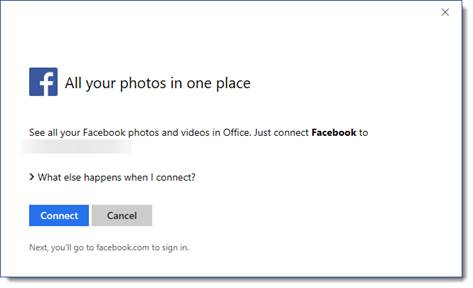
Click Connect.
You'll then be prompted to sign in to your Facebook account:
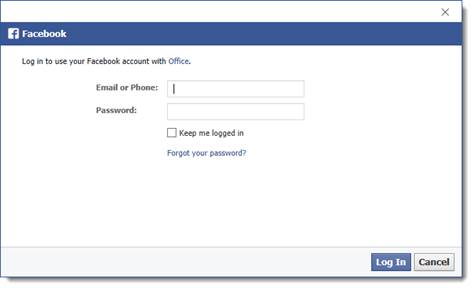
Click Log in. Once you're logged in, you'll see this screen:

Click Done.
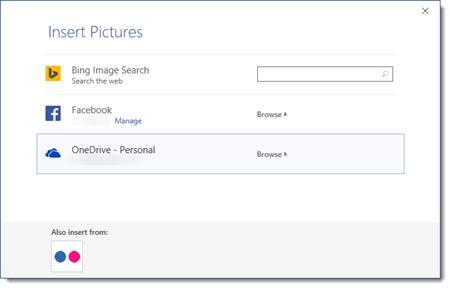
As you can see in the snapshot above, Facebook is now listed as a location for online pictures. Simply click Browse to search your Facebook photos and find one to insert into your spreadsheet.
If you want to add pictures from Flickr, click the Flickr button at the bottom to connect to your Flickr account the same as you did for Facebook.
Crop a Picture
When you crop a picture, you cut away the outer edge of the picture to create a new version.
Let's crop the picture below.
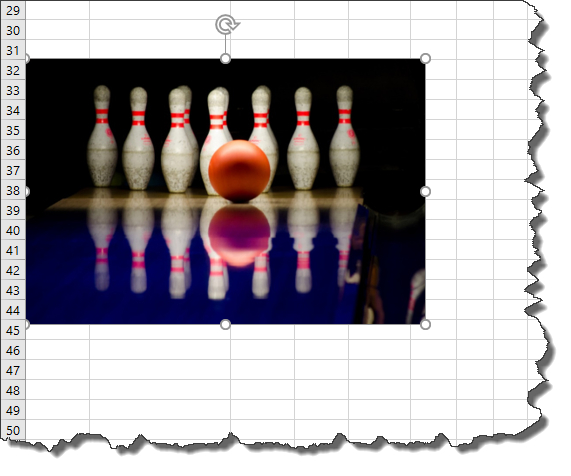
Go to the Picture Format tab. If you don't see the Picture Format tab, double click on the image. Click Crop from the Size group.

Your cropping options are now displayed in the dropdown menu.

Select Crop.
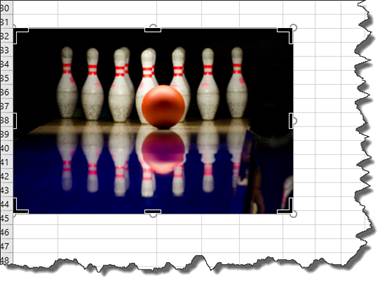
As you see above, there are now black crop handles at each corner of the image and halfway across each edge. These crop marks look like "L" and dashes.
Click and drag your mouse on any of these marks. Click and drag inward on the image until you have cropped away the area you want to get rid of in the image.
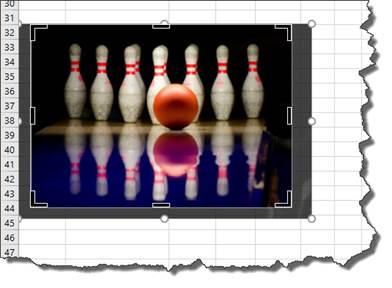
The area you're cropping away is shaded in dark gray.
Click outside of the image to remove the cropped area.

Color
You can easily adjust the color of any image you place in your spreadsheets.
To do this, double click on the image.
You'll then see the Picture Tools Format Tab. Click the Color button:
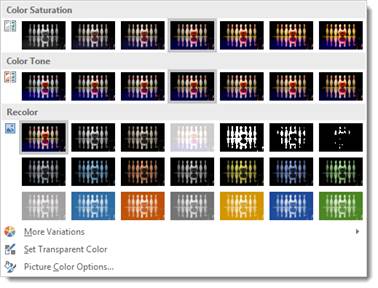
Choose the color effect you want to apply to your image.
Color Correction
You can also adjust and modify the colors in your image through color correction. Once again, go to the Picture Tools Format tab by double clicking your image.
Click the Corrections button.
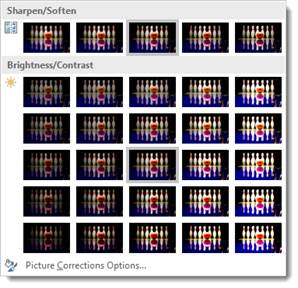
Choose a color correction.
Artistic Effects
Just as you can use Photoshop and other photo editing software programs to add effects to your images, you can also use Excel for this.
Double click your picture to bring up the Format tab, then click the Artistic Effects button.
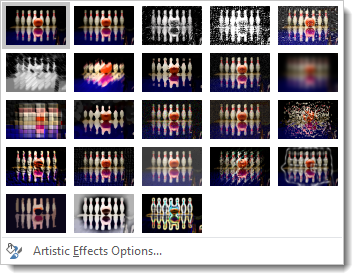
Choose the artistic effect that you want to apply to your image.
Rotating an Image
To rotate an image, we click the Rotate button in the Arrange group under the Picture Format tab.

Decide how you want to rotate it by making a selection in the dropdown menu:

We're going to Rotate Right 90 degrees.
Excel rotates the image for us.

NOTE: You can also rotate images by selecting the image, then dragging on the arrow above the image. The arrow looks a lot like the Redo button.
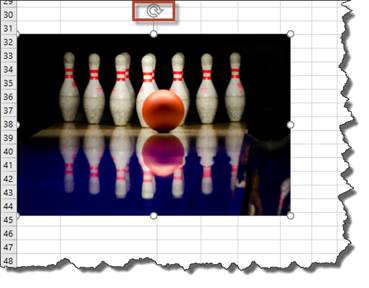
Changing the Borders of a Picture or an Image
The picture border tool is located in the Styles group on the Picture Format Ribbon in the Picture Styles group.
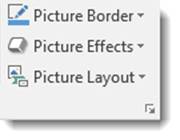
Border refers to the border around the outer edge of a selected element. To change the border of an image, you can click this button in the toolbar, and then select the desired color, weight (thickness), and style of the line.

Adding Styles to Images
In addition to adding borders to images, you can also add a style. A style can give the image a 3-D effect, add borders, shadows, and reflections.

To add a style, select the image, then choose a style from the Pictures Styles gallery under the Picture Format tab.
Removing Backgrounds from Images
Although Microsoft Excel is a spreadsheet program, it also offers some photo editing tools, as we've already seen in this lesson. Perhaps one of the most useful photo editing tools found in Excel 2016 is the background removal tool. This tool allows you to remove backgrounds from your images.
We are going to remove the background from our image:

To use this tool, double click on the image for which you want to remove the background. Click on the Remove Background button in the Adjust group under the Picture Tools Format tab.

When you click the Remove Background button, you will see the Background Removal tab appear on the Ribbon.

Your image's background � and possibly your image � will also change colors. Don't worry. This is temporary.

The areas that appear in purple are the areas that Excel has determined are background areas that it needs to remove. If there is purple on any areas of your image that you want to keep, you can drag the handles of the bounding box that appears over the image. Drag the handles outward to keep more of the image.

In the snapshot above, you can see we have dragged the handles outward. As we did so, more parts of the image returned to their regular color, which means those areas are not background areas. However, Excel is still recognizing a lot of the foreground image as background, and we need to change that.
After you adjust the bounding box, if there are still areas of your image that are purple that are not supposed to be purple, go to the Background Removal tab in the Ribbon. Remember, any areas that are purple are considered background areas by Excel.
Click the Mark Areas to Keep button.
Your cursor will turn into a pencil.
Simply click on any area that you want to keep.
You can also click on the Mark Areas to Remove to remove any areas that appear as foreground but should be background.

As shown in the snapshot above, a plus sign appears where you clicked areas to keep. Minus signs appear if you clicked areas that should be removed.
When you're finished, click the Keep Changes button in the Ribbon.
In our image below, we removed the background and then cropped the image.
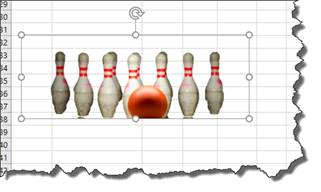
Resize and Move Images
You can resize and move images after you insert them into Excel.
To resize images, go to the Picture Tools Format Ribbon. Go to the Size group and enter a size in inches for the height and width.

You can also resize a picture by dragging in or out on its handles on the bounding box in the spreadsheet.
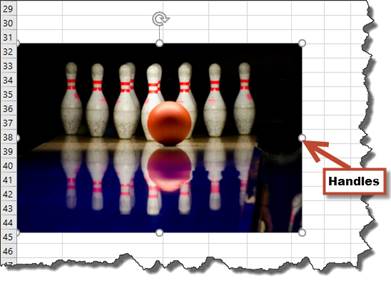
To move an image, click on the image so it's selected. Move your mouse cursor over the image. The cursor will turn into two arrows that look like a plus sign. Now, drag your image to its new location, then release
Compressing a Picture
You can reduce the file size of a picture by using the Compress Picture command. This reduces the resolution of the picture for quicker downloading and removes unnecessary information. For instance, when you crop a picture, the cropped portions of a picture are still stored in the file, they have only been "hidden."
The Compress Picture button is located under the Picture Format tab in the Adjust group.

Click the Compress Picture button.
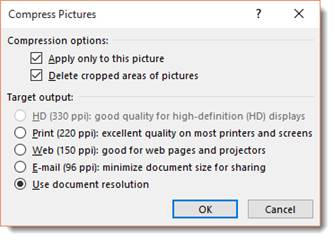
Choose the options you want, and click OK.The E-mail option reduces picture resolution to 96 dpi, or dots per inch. This helps increase the send/receive speed of your spreadsheet when you email it.
Reset Picture
Use the Reset Picture button on the Picture Format ribbon to reset the picture to its original size and format.
Adding WordArt
You might be familiar with WordArt from Excel's sister program Word. You insert WordArt into Excel much the same as you insert a picture.
Go to the Insert tab and select WordArt from the Text group.

You will then see the WordArt gallery.
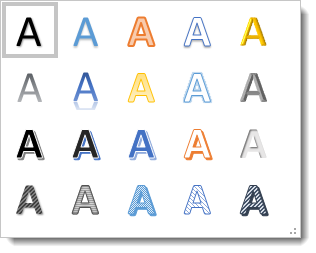
Select a style by clicking on it.
Click inside the box on your spreadsheet to type in your own text.

When you add WordArt, the Drawing Tools Format tab opens in the Ribbon.

From here, you can format your WordArt by applying a style, fill (the inside coloring of the letters, shape outline (the outline color of the letters), and even text and shape effects, such as drop shadow, reflection, etc.
Inserting Shapes
There is so many things that you can do to customize your Excel spreadsheet. One of those things is adding shapes.
To add a shape, go to the Insert tab and click the Shapes button in the Illustration group.
Select a shape from the dropdown menu.

Select a shape. We've selected a cloud in the Callout section. Now simply click in the spreadsheet where you want the shape to appear:
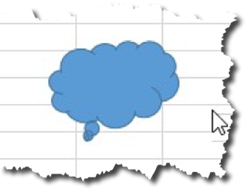
You'll see a bounding box around the shape:
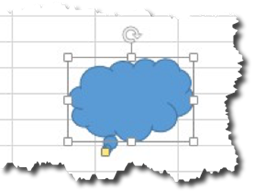
The little arrow at the top of the shape that looks like the Redo sign can be used to rotate the shape to the left or right.

You can drag on the handles (the little squares) to enlarge or reduce the size of the shape.

Double click the shape to bring up the Format tab on the Ribbon:

Shape and Text Effects
Text Effects and Shape Effects are visual effects that you can apply to word and shapes in your Excel spreadsheets. Shadow, glow, and reflection are examples of the visual effects that you can add. That said, when you add visual effects to your text or shapes, you want to select a visual effect that matches the look you want to create. You don't need to worry about what type of effect is.
To add visual effects to Word Art text, double click the WordArt to go to the Drawing Tools Format tab, then go to Text Effects in the WordArt Styles group.
To add visual effects to shapes, double click the shape to go to the Drawing Tools Format tab. Go to Shape Effects in the Shape Styles group.
You can then apply various visual effects to your text and shapes.
You can pick:
- Outline which will create an outline around the letters of your text or shape.
- Shadow which will add a drop shadow to your text or shape.
- Reflection which will create a reflection of your text or shape.
- Glow which will add a glowing effect to your text or shape.
- Bevel which will add a bevel to your text or shape.
- 3-D Rotation which will rotate your text or shape to give it a three dimensional effect.
- Transform (Text Only) transforms the shape of your text. By default, text goes from left to right in a horizontal line. When you transform your text, you can have it appear in a circular shape or as a wavy line.
By clicking on any of these effects in the dropdown menu, you can see the various options for the effect.
Create a Hyperlink
A hyperlink is a link to a website or location on the Internet � or even your computer if the person reading your spreadsheet has access to your computer files. To insert a hyperlink into a spreadsheet, go to the Insert tab, then the Links group. Click the Hyperlink button.

You'll see this window:
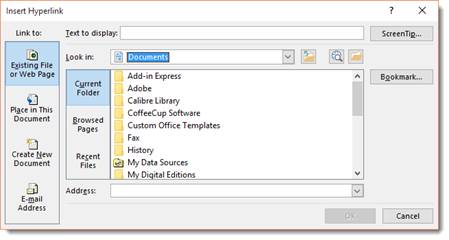
In the Text To Display field, enter in the text you want displayed in your spreadsheet. This will be the text people can click on to take them to the web page. It doesn't have to be a URL. You can type in the word "cow" if you want.
Choose what you want to link to. We've chosen a place in the spreadsheet.
Click OK when you're finished.
Embedding an Object
To embed an object into Excel, select a location, then click the Insert tab, then the Object button in the Text group.

The Object dialog box will open.
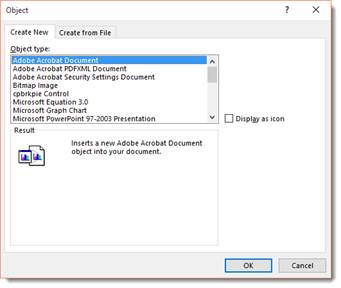
As you can see, you can now choose an object to embed. We're going to scroll down and embed a WordPad document.
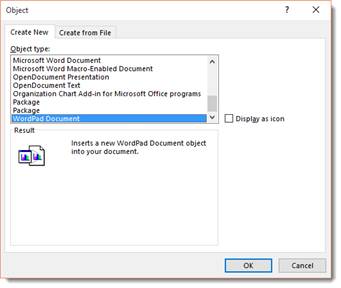
Click OK when you've chosen your object.
We now have a WordPad spreadsheet open on top of our spreadsheet.
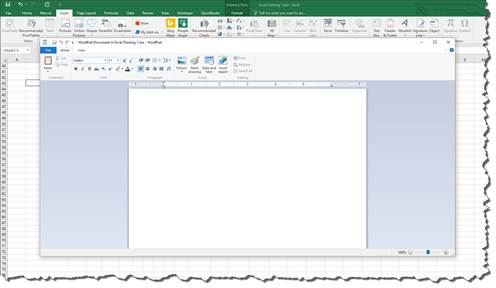
Start typing into the WordPad document.

When you're finished, click the File tab in the WordPad document.
Select Exit and return to document.
The object is now embedded. You can resize, move, and even format the object.

Textboxes
Sometimes, you don't want to type in a cell. Perhaps you have a picture that you need to add a caption for or you want to type instructions. For things like this, you create text boxes to enter in text. Text boxes can easily be moved, resized, and repositioned (along with the text inside them) to make creating a layout easy.
To create a textbox, go to the Insert tab and find the Text box button in the Text group.

Click the Text Box button.
The cursor changes to a downward arrow over your spreadsheet.
Simply click and drag to draw your text box. You do not have to draw it according to cells. In other words, you don't have to worry about starting at the top corner of one cell and dragging. You can put it wherever you want.

When you quit dragging and release your mouse, the cursor will appear in the text box.
Enter your text.
You can format the text in a text box the same way that you format a cell.
